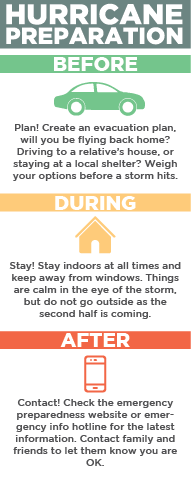Hurricanes are a part of life in South Florida – it’s how the university became the home of the Hurricanes – but, in the peak of hurricane season, it is critical that students understand the dangers of hurricanes and how to prepare for major storms.
In Florida, Governor Rick Scott proclaimed September Florida Preparedness Month.
“Florida Preparedness Month serves as a reminder to Florida’s residents and visitors that a disaster can happen any time and the best way to recover is by preparing,” said Bryan Koon, Florida Division of Emergency Management director in a statement released Wednesday.
Nationally, September is also Preparedness Month, which means the Office of Emergency Management will educate the university on safety measures as well as a new hurricane evacuation policy.
“It’s not a common occurrence, but we have to be prepared that it could happen at any time,” said Scott Burnotes, director of emergency management. “It could be next week, it could be next year, it could be another 20 years from now, who knows. But now that we know of the risks and it’s changed, we’ve changed our plans accordingly, and we’re trying to stress that the student body, the parents, our employees have to be prepared accordingly.”
In Miami-Dade County, evacuation policies are based on storm surge, the amount of water that comes in from hurricanes. The county announced in May, after conducting more extensive research and creating better models, that there is a higher risk of storm surge than previously believed.
Historically, the storm surge evacuation zone included 500,000 people living in the barrier islands, Miami beaches and coastal areas. That has been extended to include 1.5 to 1.8 million people across South Florida, according to Burnotes. Included in this extended area are the three University of Miami campuses.
Rather than a tidal wave of water, the storm surge expected in the county is water being pushed up canals and flooding surrounding areas, which could cause major problems at the Coral Gables campus, which is divided by a canal and has a large lake.
“For major hurricanes, we’re going to be super proactive,” Burnotes said. “We’re not going to wait for the county to tell us if we believe that there’s potential for it to be a major hurricane. We want to give the students and employees as much time as possible to implement their evacuation plan or for employees living locally to do what they need to do to protect their families and protect their house.”
If a category three, four or five hurricane is expected to hit, students will need to self-evacuate or sign up for university aid. The Office of Emergency Management will issue a notice that the university will be closed and students who can self-evacuate must do so by a certain point. The university will send an email for students who wish to sign up for transportation to both Miami International Airport or Fort Lauderdale-Hollywood International Airport.
For those who do not have the means or the option to self-evacuate, the university will send an electronic survey asking students to self-identify if they need shelter. The university will then take those students to a local shelter run by the Red Cross outside the evacuation zone. This option is available to undergraduate, graduate, medical and law students living on or off campus.
Burnotes also suggest students who live off campus visit tinyurl.com/md-hurricanezone, to see if they live in an evacuation zone and to prepare accordingly.
For tropical storms and category one or two hurricanes, the policy has remained the same. Just like last year, when the university closed due to Hurricane Isaac, students will be sheltered in the residential buildings.
“The buildings went into lockdown mode, but I think people were allowed out, but they had to sign waivers and we had a cop at the entrance, so they had to sign if they wanted to go out of the building,” said senior Jaime Ceron, a residential assistant in Stanford Residential College. “UM, especially the Division of Student Affairs, always makes students’ safety its number one priority.”
The Office of Emergency Management hopes to emphasize that students need to be proactive and make plans before any storm approaches, as well as take advantage of the resources offered by the university.
“That’s why we’re really stressing for students to know what they’re going to do now so that when we have to make that decision, they’re not thinking ok what am I going to do? They already have it in their mind,” Burnotes said, “It’s those types of things we want people thinking about during blue skies.”







